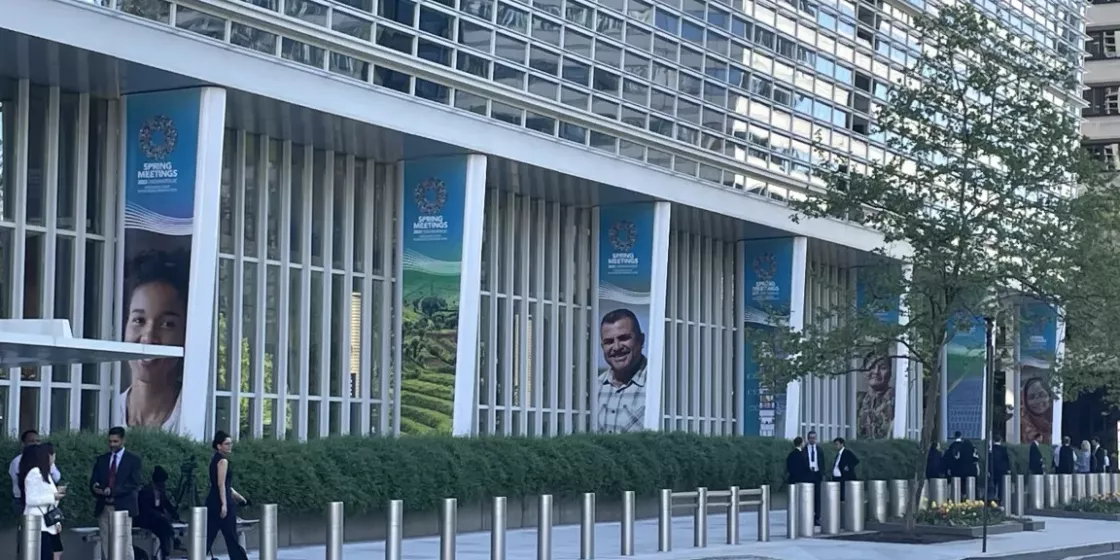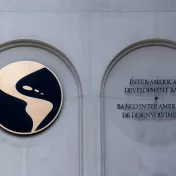This blog was written together with Jake Schmidt (NRDC), Erin Landy (E3G), and Laura Sabogal (E3G).
The World Bank Group (WBG) has published the first set of documents beginning to detail how they will align their investments with the Paris Agreement – the so-called “Paris Alignment Methodology”. The publication of these methodologies is a long overdue first step to deliver on the commitment to align the WBG operations with the goals of the Paris Agreement. They will need to be strengthened and clarified to fully align the WBG investments with the Paris Agreement.
The WBG has committed to align 100 percent of new operations beginning July 1, 2023, with 85 percent alignment for its two private sector arms – the International Finance Corporation (IFC) and the Multilateral Investment Guarantee Agency (MIGA). The IFC and MIGA commitments increase to 100 percent beginning July 1, 2025. The WBG has detailed four overarching papers laying out its proposed methodology for Paris Alignment – an overview and three specific investment “instrument methods” papers – with six sectoral notes recently published. The sectoral notes outline specifically how this methodology will be applied to particular sectors and investment strategies (see WBG blog for details on the sectoral notes that are forthcoming).
How the WBG aligns its investments with the Paris Agreement is critical since the WBG’s total investments are over $90 billion per year and the institution has invested over $16 billion in fossil fuels since the Paris Agreement was adopted, including over $1.6 billion in 2021 alone. The WBG investments also catalyze other investments and send market signals to the private sector – these signals should ensure its investments are helping (not hurting) the world’s efforts to drive other investments towards stronger climate action.
While it is important and extremely welcome that these documents are finally out, there are key areas for further improvements based upon the four documents presented so far. Additional strengthening will likely be needed around the sectoral notes as we dig into their details.
Aligning WBG methodology with 1.5°C mitigation: Do they add up to actual Paris targets?
The methodology documents detail that the defining criterion for the Bank’s financing decisions are the countries’ national decarbonization trajectories in the form of nationally determined contributions (NDCs), Long-Term Strategies (LTSs), and Country Climate and Development Reports (CCDRs) if available. This appears to be a relatively low bar for meeting the pledge to align with the Paris Agreement. In many cases NDCs and LTSs don’t suffice as an indication for Paris Alignment as they:
- fail to be consistent with the ultimate mitigation goal of the Paris Agreement,
- don’t cover all the emissions from a country,
- are missing from some countries (i.e., not all countries have LTSs or CCDRs), or
- are out of date and don’t reflect national or international commitments (e.g., those made in the context of the Just Energy Transition Partnerships).
According to independent assessments, the NDCs would result in an emissions trajectory consistent with a 2.4°C pathway and full implementation of countries’ long-term targets would result in a temperature rise of 1.8°C. So, by definition, basing the WBG methodology on these plans would be inconsistent with a Paris aligned mitigation pathway as stated in the Paris Agreement (Art 2.1a): “Holding the increase in the global average temperature to well below 2°C above pre-industrial levels and pursuing efforts to limit the temperature increase to 1.5°C above pre-industrial levels”.
The WBG methodology overview paper reiterates the Paris principle of common but differentiated responsibilities and respective capabilities and states that “a core assumption underpinning the WBG Paris Alignment Commitment is that countries have flexibility in defining their own contributions to the overarching goal of the Paris Agreement”. While flexibility in how to reach the common temperature goal is important, the WBG’s approach however neglects the Paris goal altogether in that it fails to include respective tests and adequate strategies to support countries in meeting their responsibility.
The Paris Agreement recognized this dynamic between flexibility and ambition by setting in place a multi-part process to both meet the common temperature goal and addressing differentiated capabilities: (1) an expectation and call to further strengthen NDCs; (2) a Global Stocktake to assess progress towards the Paris goals; (3) efforts by developed countries to support greater action with finance and technology support; and (4) a process where NDCs (and LTSs) would be further strengthened until the world was on a 1.5°C pathway.
As a result, the WBG should reform its approach by:
- Altering its methodology to ensure its financing is aligned to the temperature goals of the Paris Agreement, as stated by Senior Managing Director Axel van Trotsenburg, rather than base the methodology on country strategies. It could do this by adding an additional 1.5°C temperature goal scenario check to the methodologies. Furthermore, the World Bank should leverage its CCDRs to determine how the sum of its country operations keeps the world on track to non-catastrophic warming. The CCDRs are a potentially standard-setting vehicle if they are based upon 1.5°C aligned strategies – this should become part of the CCDR process moving forward.
- The World Bank should meet a differentiation in countries’ capability with a differentiation in support. It could increase its ambition by committing (in such circumstances) to accompany investments with support to countries for either improving developing their national strategies or to help them develop projects that are compatible with a 1.5°C pathway even if the national strategies are not.
Aligning WBG methodology with adaptation and resilience needs
The WBG is a major contributor to adaptation finance with a reported $12.9 billion last year. At the same time, its “non-climate” finance often touches upon areas where climate impacts will be felt or where a country could integrate adaptation strategies to ensure that its development is as “climate proof” as possible. The WBG climate action plan recognizes the need to integrate adaptation in its five key focused sectors stating that these sectors: “face significant adaptation challenges, which makes support for adaptation a critical priority for all five”.
To better support adaptation and resilience strategies, the WBG Paris Alignment methodologies could be improved by:
- Clarifying several quantitative terms relevant to adaptation strategies such as “an acceptable level of residual risk” or “project level risks could significantly increase existing vulnerability to climate hazards” [emphasis added]. The definition of these terms and their consistent application across multiple WBG strategies will play an important role in Paris alignment and demonstrates the WBG’s accountability. [Note: a similar clarification is critical to the application of these terms for mitigation where “significant increase in GHG emissions” or “low risk of locking in carbon-intensive patterns” are similarly undefined. We recommend amending this to make “low” instead “near zero”.]
- Stressing that the investments are only aligned with the Paris Agreement when they achieve the maximum outcomes around adaptation and resilience for the given investment (all other things being equal). Paris alignment doesn’t just mean “doing no harm” to the adaptation and resilience of a country but rather helping to ensure that the investments are “increasing the ability to adapt to the adverse impacts of climate change and foster climate resilience” (Art. 2.1b of the Paris Agreement). [Again, a similar element is true of the mitigation methodologies that assess an investment is aligned if it reduces GHG emissions or increases sinks – not significantly or to the maximum extent possible.]
- Assessing adaptation-related risks and potential not only with a restricted focus on the development objective of the single operation under consideration, but with a view to the country’s broader adaptation needs. More technical assistance for the creation of National Adaptation Plans, and country platform approaches to adaptation, are essential.
- To fully align with Building Block 2 on adaptation of the joint MDB Paris alignment methodology, the WBG should be scanning all potential opportunities for integrating resilience measures in its financing not only if there are relevant “climate hazards” as stated under the IPF methodology point 51.
Tightening or clarifying key points: some unknowns
There are several aspects of the methodologies which will either need to be clarified in the sectoral notes or could significantly benefit from additional detailed notes to limit the room for major loopholes. These clarifications include:
- Unpacking the analysis methodology for assessing a lower-GHG emissions means to achieve development goals (‘alternatives analysis’): How the alternatives analysis is conducted is critical to ensuring that the high-emitting activity is credibly assessed against the low-carbon alternative or avoids stranded assets. (For example, NRDC and the Sierra Club outlined some key factors that would need to go into such an alternatives analysis for fossil fuel projects.) This is particularly important with regards to “footnote 6” of the IPF methodology, which states: “In some cases, even investments that are associated with relatively high GHG emissions may be deemed Paris-aligned if there are no technically feasible and economically viable lower-emission alternatives in the specific country and sector context that can meet the same development objectives, provided the risk of creating persistent barriers to the transition to low-carbon development is low”. This footnote should be amended so that persistent is replaced with “any”.
- Detail the method for assessing lock-in risks: Especially in the current absence of a 1.5°C-compatibility test, the lock-in test has crucial weight in the bank’s decision-making process. The WBG needs to publish the criteria, method and parameters that will be used to determine the existence of lock-in risks (including its understanding of “lower-carbon alternatives”).
- Tighten the requirements for Development Policy Financing (DPF) around financing highly emissive assets in lower-income countries. To prevent a potential loophole, the WBG should establish the same requirements in the DPF methodology as listed in the Investment Project Financing methodology (IPF) which requires: (a) a robust analysis of economically and technologically feasible low-carbon alternatives to ensure the lowest carbon option is chosen; (b) a transparent analysis of lock-in risks as well as stranded assets; (c) an analysis of any transition risks and its corresponding mitigation strategy; and (d) a clear strategy to support countries to strengthen their regulatory framework to enable the deployment of low carbon technologies.
- Defining and tightening the list of “universally aligned and unaligned” projects. Assessments are also based on a list of universally aligned and non-aligned activities. It is unclear whether the WB refers here to the joint MDB catalog of universally (non)aligned activities or whether it has its own (unpublished) version. This needs to be clarified by the WBG. However, the joint MDB list has several issues since the non-aligned list does not include all coal-related support, and also does not include Paris-incompatible oil and gas support (e.g., anything related to the exploration and opening of new fields, new midstream infrastructure, and other activities that increase the demand for natural gas). Similarly, the joint MDB aligned-list is problematic since it includes a number of categories which would need more differentiation, such as, e.g., all port infrastructure and most other transport activities, non-ruminant livestock, aquaculture, all public service activities etc. At the same time, this list does not include public financial management, the banking sector, or general private sector/business support – where it would be helpful to identify climate-positive activities.
Making them better over time: public consultation, transparency, and improvements
To deliver a high-standard Paris alignment methodology, the WBG will need to deliver a robust process to ensure greater transparency and improvement over time by:
- Providing a more meaningful process for public consultation on the methodologies. While it is important that these documents were posted online, it is unfortunate that they were put forward so close to the July 1 start date and without a formal consultation process, as it constrains the provision of meaningful expert recommendations for improvement before the methodologies go into practice on July 1. The World Bank should be applying the ‘many eyes’ principle to maximize the quality of this complex work.
- Make documentation and decisions transparent. The WBG has committed that each proposed investment will include a summary of how the staff have assessed that it is Paris aligned. But they need to go a significant step further by publishing for the WBG Board and outside stakeholders the underlying documentation detailing how they decided that a project was Paris aligned or not. The key assumptions, detailed analysis, models behind the analysis, and other quantitative results will be critical in holding the bank accountable and ruling out potential flaws in the analysis. These detailed documents should be made publicly available at least 6 weeks in advance of a Board decision so experts have a chance to assess their credibility. Furthermore, we understand that there will be an internal intranet within the WBG where details of projects that have failed the Paris Agreement test will be posted for internal use. This should be shared with other MDBs, project promoters and recipient governments too.
- Iterate and improve rapidly. Although the documents are planned to be continually updated based on lessons learnt, there is no clear indication of how this process will happen in practice. The approach is purely ex-ante and does not detail any clear feedback loops for improving the accuracy of Paris Alignment methods over time (or within the timeframe of the project). There is also no clear process for holding the bank accountable to facilitating Paris-aligned outcomes in activities, which is a missed opportunity for increasing knowledge and effectiveness for these purposes. The WBG should be explicit that the full methodology will be under review in quarter 3 of this fiscal year so that any modifications can be applied for the next fiscal year. But the Board of the WB shouldn’t have to wait a full year to adjust so there should be a regular review of the application of the methodology to make any necessary mid-year course corrections.
Moving from a “do no harm” principle to driving the necessary action at scale
The WBG’s Paris alignment approach centers on safeguarding activities’ development objectives against mitigation- or adaptation-related risks, based on a principle of “doing no harm” to climate goals. This is highly problematic at a time when we really need investments that are driving the mitigation and adaptation/resilience actions necessary to deliver on the goals of the Paris Agreement. Not making things worse is an old way of defining WBG policies.
The bank needs to recognize that a lack of transformative action will result in harm in the very near future. It therefore needs to systematically use its Paris alignment approach to direct a large share of its portfolio at generating positive climate impacts and ideally at being transformative - rather than relegating this potential to its commitments for increasing climate finance (which have begun to stagnate). This includes considering climate from step one of the country engagement process, including in diagnostics, country dialogue and strategy as well as donor coordination.
In the refining of the WBG Paris Alignment methodology and in its application to specific investments, the WBG leadership and shareholders need to reject projects that fail to deliver on those higher Paris alignment requirements, and embark on a communications drive with project promoters and recipient country governments so they are fully aware of the Paris alignment criteria.
The Paris Alignment methodology needs to move from a principle of “do no harm” to “do the maximum possible” to deliver on the Paris Agreement. If this is done, the World Bank will truly be playing its part – its leadership role – in leading the implementation of the Paris Agreement in all parts of the developing world.






